AMD A10-5800K & A8-5600K Review: Trinity on the Desktop, Part 1
by Anand Lal Shimpi on September 27, 2012 12:00 AM ESTCompute & Synthetics
One of the major promises of AMD's APUs is the ability to harness the incredible on-die graphics power for general purpose compute. While we're still waiting for the holy grail of heterogeneous computing applications to show up, we can still evaluate just how strong Trinity's GPU is at non-rendering workloads.
Our first compute benchmark comes from Civilization V, which uses DirectCompute 5 to decompress textures on the fly. Civ V includes a sub-benchmark that exclusively tests the speed of their texture decompression algorithm by repeatedly decompressing the textures required for one of the game's leader scenes. And while games that use GPU compute functionality for texture decompression are still rare, it's becoming increasingly common as it's a practical way to pack textures in the most suitable manner for shipping rather than being limited to DX texture compression.
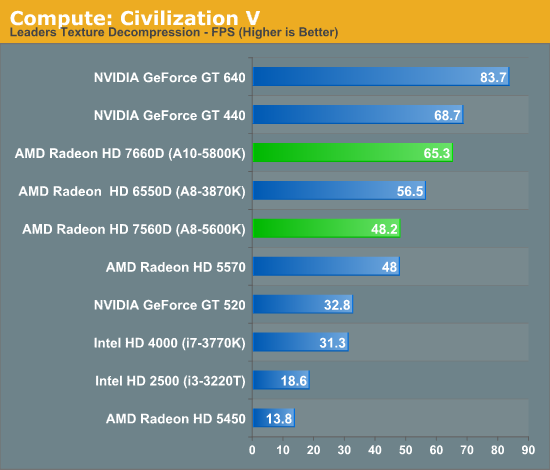
Similar to what we've already seen, Trinity offers a 15% increase in performance here compared to Llano. The compute advantage here over Intel's HD 4000 is solid as well.
Our next benchmark is SmallLuxGPU, the GPU ray tracing branch of the open source LuxRender renderer. We're now using a development build from the version 2.0 branch, and we've moved on to a more complex scene that hopefully will provide a greater challenge to our GPUs.
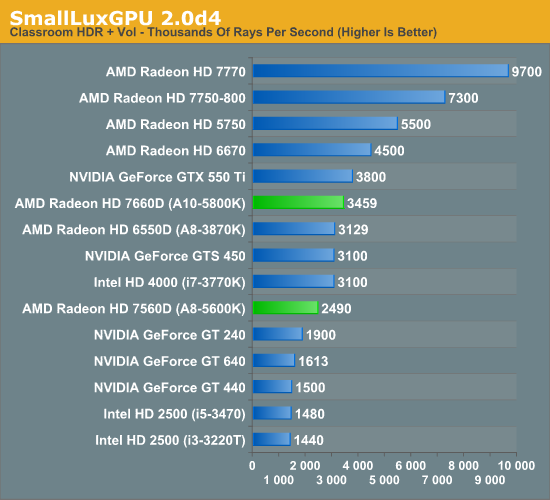
Intel significantly shrinks the gap between itself and Trinity in this test, and AMD doesn't really move performance forward that much compared to Llano either.
For our next benchmark we're looking at AESEncryptDecrypt, an OpenCL AES encryption routine that AES encrypts/decrypts an 8K x 8K pixel square image file. The results of this benchmark are the average time to encrypt the image over a number of iterations of the AES cypher. Note that this test fails on all Intel processor graphics, so the results below only include AMD APUs and discrete GPUs.
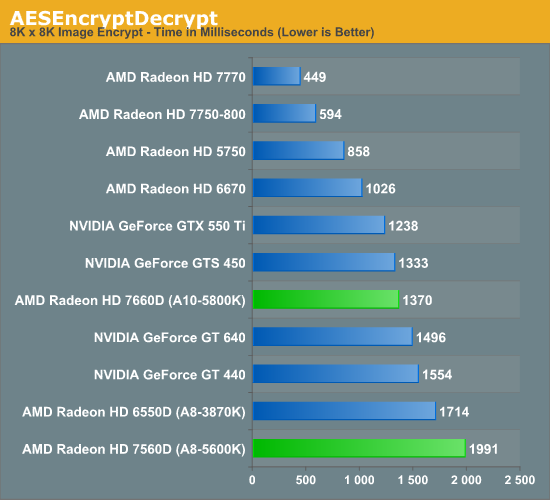
We see a pretty hefty increase in performance over Llano in our AES benchmark. The on-die Radeon HD 7660D even manages to outperform NVIDIA's GeForce GT 640, a $100+ discrete GPU.
Our fourth benchmark is once again looking at compute shader performance, this time through the Fluid simulation sample in the DirectX SDK. This program simulates the motion and interactions of a 16k particle fluid using a compute shader, with a choice of several different algorithms. In this case we're using an (O)n^2 nearest neighbor method that is optimized by using shared memory to cache data.
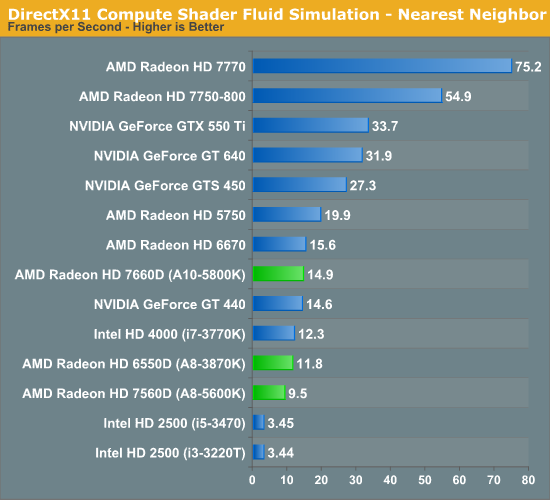
For our last compute test, Trinity does a reasonable job improving performance over Llano. If you're in need of a lot of GPU computing horsepower you're going to be best served by a discrete GPU, but it's good to see the processor based GPUs inch their way up the charts.
Synthetic Performance
Moving on, we'll take a few moments to look at synthetic performance. Synthetic performance is a poor tool to rank GPUs—what really matters is the games—but by breaking down workloads into discrete tasks it can sometimes tell us things that we don't see in games.
Our first synthetic test is 3DMark Vantage's pixel fill test. Typically this test is memory bandwidth bound as the nature of the test has the ROPs pushing as many pixels as possible with as little overhead as possible, which in turn shifts the bottleneck to memory bandwidth so long as there's enough ROP throughput in the first place.
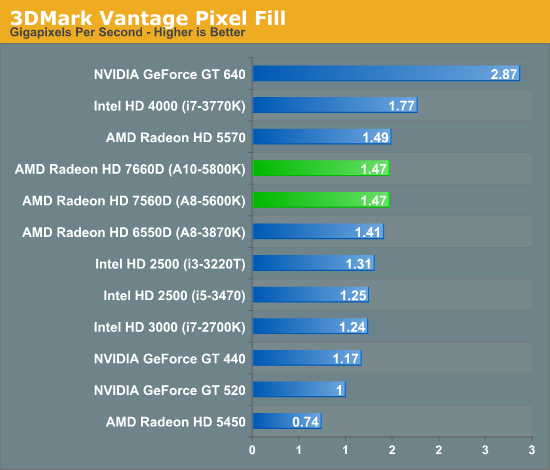
Since our Llano and Trinity numbers were both run at DDR3-1866, there's no real performance improvement here. Ivy Bridge actually does quite well in this test, at least the HD 4000.
Moving on, our second synthetic test is 3DMark Vantage's texture fill test, which provides a simple FP16 texture throughput test. FP16 textures are still fairly rare, but it's a good look at worst case scenario texturing performance.

Trinity is able to outperform Llano here by over 30%, although NVIDIA's GeForce GT 640 shows you what a $100+ discrete GPU can offer beyond processor graphics.
Our final synthetic test is the set of settings we use with Microsoft's Detail Tessellation sample program out of the DX11 SDK. Since IVB is the first Intel iGPU with tessellation capabilities, it will be interesting to see how well IVB does here, as IVB is going to be the de facto baseline for DX11+ games in the future. Ideally we want to have enough tessellation performance here so that tessellation can be used on a global level, allowing developers to efficiently simulate their worlds with fewer polygons while still using many polygons on the final render.
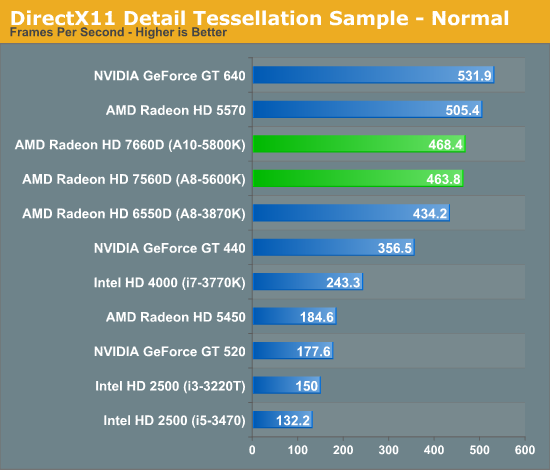
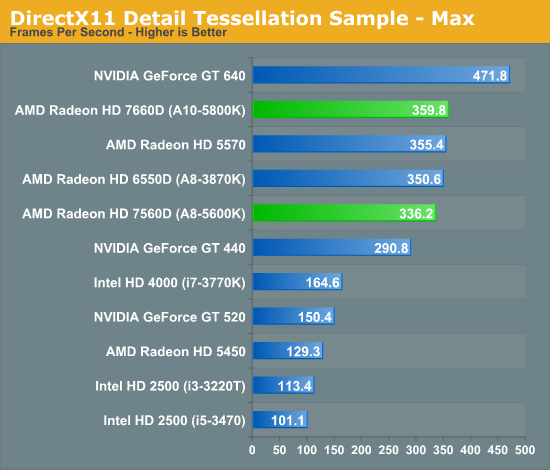
The tessellation results here were a bit surprising given the 8th gen tessellator in Trinity's GPU. AMD tells us it sees much larger gains internally (up to 2x), but using different test parameters. Trinity should be significantly faster than Llano when it comes to tessellation performance, depending on the workload that is.










139 Comments
View All Comments
leexgx - Saturday, October 6, 2012 - link
T** Hardware i have made sure i never goto there web site again (even saying there website name as google counts that towards stats)most stuff on there cant be trusted
blackmagnum - Thursday, September 27, 2012 - link
I hope AMD aim their products for first place in the best price/ performance race with Intel. This seems the only way they will be bought other than for the health of competition or nostalgic sense of pity.duploxxx - Thursday, September 27, 2012 - link
pity for what? do you really think you need more CPU perfromance then a Piledriver core deliver? Do you really think that the Trinity isn't good enough power consumption wise.Its fools who believe they need an i7 to run daily desktop usage. spend the wasted money of an i7 on a fast disc (SSD) and your overall platform experience and performance will be much higher then your so called fixed brand name.
daos - Thursday, September 27, 2012 - link
are you serious? people use computers for more than "daily desktop usage". Video editing, graphics design, multi-threaded apps, benchmarking, even gaming...Every bit counts the larger the scale. CPUs can make a huge difference in all of the above mentioned except for maybe gaming unless at an enormous resolution like I am.
And you have to remember that everything is relative. You are concerned with wasting your money whereas the next guy could care less about an extra 2 or 3 hundred dollars for the best. Thats a drop in the bucket for him. Hell, thousands more can be a drop in the bucket if the best is what your after...its simple. Go Intel.
dagamer34 - Thursday, September 27, 2012 - link
When the average selling price of a computer is $450 in the US, I don't see how that really includes any of the things you listed above.Alexvrb - Thursday, September 27, 2012 - link
Heck, for most people, a Tegra 3 or similar in a tablet is enough computing power. A lot of people just stroll into a store and buy the advertised on-sale laptop for $300-400. For these people an APU might not be a bad choice, given that the lower-end Intel chips all have horribly crippled GPUs.lwatcdr - Thursday, September 27, 2012 - link
"Video editing, graphics design, multi-threaded apps, benchmarking, even gaming..."Some do but more and more of those tasks really benifit from a GPU boost. Most Adobe products now use openCL so they can take advantage of the GPU. That will cover Video editing, graphics design and gaming. multi-trheaded apps benifit more form core count than raw cpu and most multi-threaded apps will do just fine on th A10.
Benchmarking? Really that is called a hobby unless you are doing it to test systems for a living. You do not buy hardware just to bet a higher benchmark score you Benchmark hardware to find the cheapest way to get a task done in a reasonable amount of time. Anything else is a hobby and while that is all fine and good it is a tiny fringe element of a fraction of a percentage of the PC market.
Denithor - Thursday, September 27, 2012 - link
But this is the desktop market. It's simply too easy to install a discrete GPU that is tons faster than any iGPU, even this new Trinity. Integrated GPU just doesn't cut it for most of those applications.Maybe for an HTPC. But that's honestly the only place I'd even consider pointing anyone toward an APU over a CPU+GPU.
chrnochime - Thursday, September 27, 2012 - link
There are always people who make stupid blanket statements like yours. "People" would mean everyone. You not writing "some" in there basically means you think everyone think the way you do. If that were not the case your sentence would not have been written that way.Don't like my nitpicking? Don't write stupid blanket statements then.
mikato - Monday, October 1, 2012 - link
what do you mean "you people"?